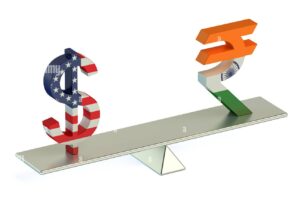
The Indian Rupee (INR) recently appreciated to 82.92 against the US Dollar (USD), but its gains were tempered by a stronger USD and rising crude oil prices. The INR is expected to face resistance near 83.10 and may retrace towards 82.80 due to strong factory output data, which reached a five-month high of 5.7% in July. However, persistent inflation above the Reserve Bank of India’s (RBI) upper target band of 6% could lead to tight liquidity conditions. Investors are also keeping an eye on upcoming US Consumer Price Index (CPI) numbers for insights into future rate paths. In the short term, the USDINR pair is anticipated to consolidate between 82.80 and 83.10, reflecting the complex interplay of domestic and global factors influencing the Rupee’s performance.
Introduction
The Indian Rupee (INR) has been a subject of constant scrutiny and discussion among traders and investors. Its value in the global market is influenced by a multitude of factors, including economic data, global events, and central bank policies. In this blog post, we delve into recent developments surrounding the INR, shedding light on its current trajectory, the impact of strong factory output data, and the potential consequences of sticky inflation numbers.
Rupee’s Recent Appreciation
On a recent Tuesday, the Indian Rupee showed signs of appreciation, trading at 82.92 against the US Dollar (USD). This upward movement was notable, especially as it occurred in anticipation of key economic indicators. However, the Rupee’s upward momentum faced challenges from a stronger US Dollar and rising crude oil prices. These factors combined to limit the Rupee’s gains.
Hurdles Ahead: 83.10 and Beyond
As the Rupee approached the 83.10 mark, it encountered a significant hurdle. This resistance level suggests that further appreciation may be a challenging endeavor. Market analysts anticipate a retracement towards the 82.80 level, driven by robust factory output data.
Factory Output Data: A Positive Sign
One of the key drivers behind the Rupee’s recent performance is the impressive factory output data. In July, India’s factory output surged to a five-month high, registering a growth rate of 5.7%. This development signals increased economic activity and production within the country. Such positive economic indicators can have a favorable impact on the currency’s value.
Inflation Concerns Loom
While strong factory output data offers optimism, concerns persist in the form of stubborn inflation numbers. Inflation in India remains above the Reserve Bank of India’s (RBI) upper target band of 6%. This could potentially force the RBI to maintain tight liquidity conditions to curb inflationary pressures. Such a policy stance might influence the Rupee’s exchange rate.
Looking Ahead: US CPI Numbers
In addition to domestic factors, global events also play a crucial role in shaping the Rupee’s performance. Traders and investors are keeping a close eye on the upcoming release of key US Consumer Price Index (CPI) numbers. The outcome of these data points could provide further insights into the future path of interest rates and exchange rates.
Conclusion
As the Indian Rupee navigates through various economic and global challenges, its trajectory remains subject to a delicate balance of forces. The recent appreciation to 82.92, coupled with robust factory output data, suggests a potential positive outlook. However, inflation concerns and global events, such as the US CPI release, add complexity to the Rupee’s path. In the short term, it is expected that the USDINR pair will consolidate within the range of 82.80 to 83.10. In the long run, the Rupee’s performance will continue to reflect the ever-changing economic landscape, making it a dynamic and intriguing currency to watch for traders and investors alike.
